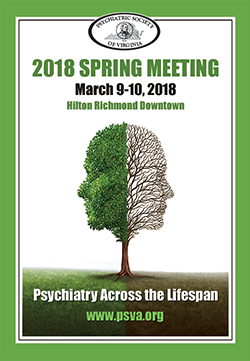Winter 2017 Issue |
|
In the News
Tramadol ER for Medical Management of Opioid Use Disorder Taper
By Meredith Roach, MEd
MD Candidate 2019,
EVMS
Virginia Department of Health data reports emergency department visits for opioid overdose rose 89% for January-September 2016 compared to the same time period in 2015. In 2014, more people in Virginia died from opioid overdoses than fatal car accidents.(1) In order to combat the opioid addiction epidemic, providers should be aware of effective methods for helping patients detoxify and prevent relapse.
The goal of medical management of opioid withdrawal is to safely detoxify patients while minimizing acute withdrawal symptoms. This can be achieved with opioid and non-opioid medications and supportive treatment for symptoms. Severity of opioid withdrawal symptoms can be assessed with the Clinical Opioid Withdrawal Scale (COWS).(2) It is important to note that while opioid withdrawal symptoms can be effectively managed in an inpatient setting rather quickly, the long-term outcomes are poor without outpatient support.
A recent randomized clinical trial compared medications commonly used in supervised opioid withdrawal, clonidine and buprenorphine hydrochloride, with tramadol hydrochloride extended release (ER). This study considered the relative risks and benefits of each drug as well as the clinical and patient reported outcomes among 103 participants being treated for opioid use disorder (OUD).
Clonidine is an unscheduled alpha-2 adrenergic agonist that provides relief of withdrawal symptoms such as nausea, diarrhea, vomiting, and sweating without the risk of opioid overdose or tolerance. However, as a non-opiate, clonidine is less effective in treating symptoms of anxiety and craving. Buprenorphine hydrochloride is a Schedule III muopioid receptor partial agonist that at low doses provides pain relief and reduction of anxiety and craving. As the dose of buprenorphine increases, it offers the benefits of blocking receptors from full opioid agonists, acting as an antagonist and reducing potential for overdose. Drawbacks to buprenorphine include its abuse potential, schedule class, and cost. Tramadol is a Schedule IV mild to moderate opioid agonist with less abuse liability than full agonists.
The study’s primary aim was to compare the efficacy of each drug in opioid withdrawal symptoms during and after a seven-day taper. Participants receiving tramadol ER experienced:
- Better withdrawal suppression during taper than those receiving clonidine;
- Same withdrawal suppression as those who received buprenorphine;
- Less severe withdrawal symptoms during the post-taper phase compared with both of the other medications.(3)
These findings published in July 2017 of JAMA Psychiatry demonstrate tramadol ER is a promising choice for medical management of an OUD taper as it surpasses clonidine’s
- http://www.vdh.virginia.gov/home/the-opioid-addiction-crisis-is-a-public-health-emergency-invirginia/#a4
- http://www.nejm.org/doi/full/10.1056/NEJMra1604339#t=article Treatment of Opioid-Use Disorders. (2016). New England Journal of Medicine, 375(16), 1596-1597. doi:10.1056/nejmc1610830
- https://jamanetwork-com.evms.idm.oclc.org/journals/jamapsychiatry/fullarticle/2642924 Dunn, K. E., Tompkins, D. A., Bigelow, G. E., & Strain, E. C. (2017). Efficacy of Tramadol Extended-Release for Opioid Withdrawal. JAMA Psychiatry, 74(9), 885. doi:10.1001/jamapsychiatry.2017.18380.1017/S0033291701004548.
YOUR NEWSLETTER IS NOW AVAILABLE ON YOUR SMARTPHONE AND TABLET!
JOIN PSV TODAY!
REGISTER TODAY!
PSV 2018
SPRING MEETING
March 9-10, 2018
Hilton Richmond Downtown
Richmond, Virginia
APA Find a Psychiatrist
Are you accepting new patients?
Opt into APA’s “Find A Psychiatrist” database. To view the functionality or opt-in, CLICK HERE
FYI: A link for this option has been added to the PSV website so the public can find you when they are looking for help.







